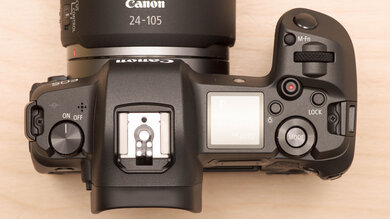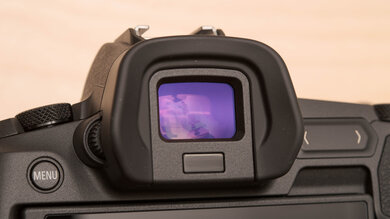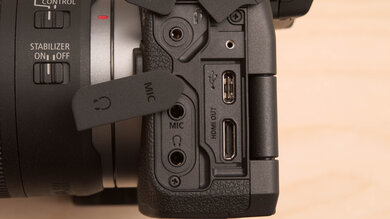The Canon EOS R is a full-frame mirrorless camera with a fully-articulated screen that you can tilt and flip based on the image you're trying to capture. It's very well-built, and it takes pictures with amazing image quality. Also, its excellent photo autofocus system helps keep moving subjects in focus. It also has decent video quality when you record in 4k and FHD, though it struggles a bit to capture clear footage in low-light settings.
Our Verdict
The Canon R is good for travel photography. This well-built camera takes clear, detailed images that are mostly free of visual noise. Its autofocus system is good overall, though it can struggle a bit more when tracking moving subjects or in busier settings. Unfortunately, it's a bit bulky and heavy, so it may not fit easily into your bag.
-
Well-built, sturdy design.
-
Amazing image quality.
-
Good photo autofocus performance overall.
-
Not very portable.
-
AF system struggles with faster subjects.
The Canon EOS R is great for landscape photography. This well-built camera may be a bit heavy, but it's still pretty easy to use. It also has excellent image quality, so photos look sharp, detailed, and free of visual noise. It isn't the most portable option for long hikes, however.
-
Well-built, sturdy design.
-
Amazing image quality.
-
Excellent dynamic range.
-
Not very portable.
The Canon R is decent for sport and wildlife photography. It takes clear, sharp images. Its autofocus system is good overall but struggles to track fast-moving subjects. Unfortunately, it doesn't have the fastest continuous shooting speed, and its buffer takes a bit of time to empty, so it's not really ideal for burst photography.
-
Well-built, sturdy design.
-
Amazing image quality.
-
Good photo autofocus performance overall.
-
Burst rate isn't the fastest.
-
AF system struggles with faster subjects.
The Canon R has impressive RAW image quality. Its dynamic range is excellent, so it can capture a wide array of detail in high-contrast lighting conditions. Its high-resolution sensor also captures very fine details and gives you some leeway to crop in. On top of that, it has good noise handling in low light.
-
Excellent dynamic range.
-
Good noise handling.
-
High-resolution sensor captures plenty of fine detail.
The Canon R is decent for vlogging. You can flip its screen to face you while you record, which is handy. It also has decent overall video quality in 4k and FHD, but your videos may have visible noise if you're recording in low-light settings. Also, if you're recording in 4k while walking, your video may not be very stable, though it has a better stabilization performance in FHD.
-
Well-built, sturdy design.
-
Good stabilization performance while walking in FHD.
-
Not very portable.
-
Disappointing stabilization performance while walking in 4k.
The Canon R is great for studio video. Video quality is great in 4k and decent in FHD when shooting in controlled lighting conditions, but it struggles a bit to capture sharp video if you're filming in low-light settings. On the upside, its video autofocus system can help keep moving subjects in focus. It also has many inputs for hooking up additional accessories like headphones or a microphone.
-
Lots of inputs for accessories like headphones and a microphone.
-
Impressive video autofocus performance.
-
Struggles to capture sharp video in low-light settings.
The Canon R isn't intended for action video. This bulky camera isn't very easy to bring with you on the go, and it can't really be mounted on a helmet. It isn't waterproof, so you can't really use it in the elements, either. It has decent overall video quality in 4k and FHD, but there may be some visible noise, especially if you're recording in low-light settings.
-
Well-built, sturdy design.
-
Not very portable.
-
Not waterproof.
- 7.7 Travel Photography
- 8.1 Landscape Photography
- 7.3 Sport & Wildlife Photography
- 8.3 Raw Photo Performance
- 7.5 Vlogging
- 8.2 Studio Video
- 4.1 Action Video
Changelog
- Updated Jan 29, 2024: Added text to the 'Raw Photo Performance' verdict box and updated existing verdict boxes for clarity and accuracy.
- Updated Jan 29, 2024: Converted to Test Bench 0.12.1.
- Updated Dec 14, 2022: Converted to Test Bench 0.12.
- Updated Nov 21, 2022: Converted to Test Bench 0.11.
- Updated Sep 23, 2022: Converted to Test Bench 0.10.
Check Price
Differences Between Sizes And Variants
The Canon EOS R comes in 'Black'. We tested the variant with the RF 24-105mm F4-7.1 is STM lens, and you can see the label for the model we tested here.
You can also purchase this camera with an RF 24-105mm F/4L IS USM lens or without any lenses at all. However, we haven't tested the camera in any other configuration, so we can't confirm its performance.
If you come across another version, let us know in the discussions so we can update our review.
Compared To Other Cameras
The Canon EOS R is better overall than the Canon EOS RP. It's a more premium camera with better build quality, including weather-sealing, a higher-resolution electronic viewfinder, and a higher-resolution sensor, not to mention a significantly longer battery life and slightly quicker burst shooting. The RP is a much more portable full-frame camera, if that's a priority, and still captures excellent image quality. Both cameras also use the same lens mount, and lenses will have a much bigger impact on your photography, so the best option between these two will be whichever one suits your budget and ergonomic preferences.
The Canon EOS R8 is a bit better overall than the Canon EOS R, though both are great full-frame options. The R8 is more portable, uses a newer processor, and offers better video features for video and hybrid shooters. Conversely, the R offers a sturdier build with weather-sealing, a higher-resolution EVF, and better battery life. Both cameras use the RF lens mount and are compatible with the same lenses.
The Canon EOS R6 is better overall than the Canon EOS R, though both are great full-frame mirrorless models compatible with the same lenses. Still, the R6 has a newer sensor and processor and an improved autofocus system that performs more reliably overall. It also has faster burst shooting and more advanced video features, including more frame rate options and better internal recording specs.
The Canon EOS R and the Canon EOS R10 have different-sized sensors, so one may suit you better than the other. The R10 is an entry-level APS-C camera, so it's more portable and lightweight. Because it's newer, it also offers a more effective autofocus system and more current video specs, not to mention faster burst shooting. The R uses a full-frame sensor and, despite being somewhat outdated in the aforementioned areas, it's a higher-end camera with better build quality, including a weather-sealed body, and features a higher-resolution sensor, viewfinder, and screen.
The Canon EOS R7 is better overall than the Canon EOS R, but the R has a larger full-frame sensor, so you may still prefer it if you do a lot of low-light shooting. The R7 is the better choice for faster subjects, action photography, and video work, with a more effective autofocus system, faster burst shooting, in-body image stabilization, and better video specs. The R has a higher-resolution viewfinder and better noise handling in low light.
If you're looking for something more well-rounded, that's the Sony α7 III. While the Canon EOS R is a great photography camera in its own right, with advantages like weather-sealing and a higher-resolution EVF, the Sony has a better autofocus system, faster burst shooting, and a more established lens ecosystem. It's also better suited to video work, with more usable frame rate options, less rolling shutter, and dual SD card slots.
The Canon EOS R and the Sony α6600 are both mirrorless cameras, but they use different-sized sensors that each come with advantages and disadvantages. The Canon is a full-frame camera with a fully articulated touchscreen and a larger, higher-resolution EVF than the Sony. It delivers better overall image quality and performs a bit better in low light. However, it doesn't have in-body image stabilization like the Sony camera, and it's less portable. The Sony also has a longer battery life and a faster continuous shooting speed for quicker burst shooting.
The Canon EOS R and the Nikon D780 are both premium full-frame cameras, though they use different camera technologies. The Canon is a mirrorless camera, while the Nikon is a DSLR. The Nikon uses an optical viewfinder, giving you a direct lag-free view through the lens, while the Canon has no mirror mechanism and relies on an electronic viewfinder, which lets you preview exposure settings live through the viewfinder. The Canon is lighter and more portable, but the Nikon has much longer battery life. Unfortunately, the Canon can only shoot 4k video with a severe 1.75x crop and only has a single SD card slot, unlike the Nikon, which has two. Otherwise, they both deliver excellent image quality and effective autofocus performance.
The Panasonic LUMIX FZ80 and the Canon EOS R are different camera types. The Canon is an interchangeable lens mirrorless camera with a full-frame sensor, while the Panasonic is a fixed-lens budget bridge camera with a small sensor. The Panasonic offers convenience for those who don't want to switch out different lenses, giving you a lot of zoom range in an all-in-one package. However, the Canon is a significantly better camera, giving you better image and video quality, sturdier weather-sealed construction, longer battery life, and quicker, more accurate autofocusing, to name some advantages.
Test Results
- Textured handgrip is big enough for most hand sizes and provides a secure hold
- Rubber pad on the viewfinder for comfort
- All frequently-used functions available in the Quick Menu on the screen
- Changing aperture and shutter speed via the command dials is easy with your eye pressed up against the viewfinder, but adjusting the ISO requires an extra button input beforehand
Comments
Canon EOS R: Main Discussion
Let us know why you want us to review the product here, or encourage others to vote for this product.
This product has been merged with Canon EOS R camera. Follow the discussion here.































































